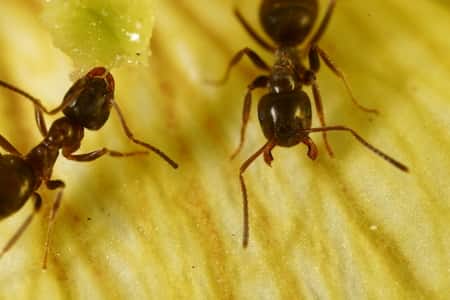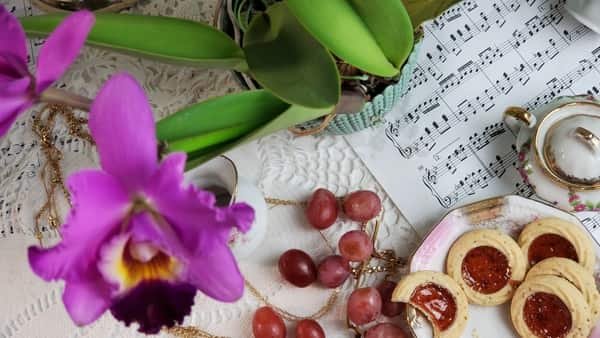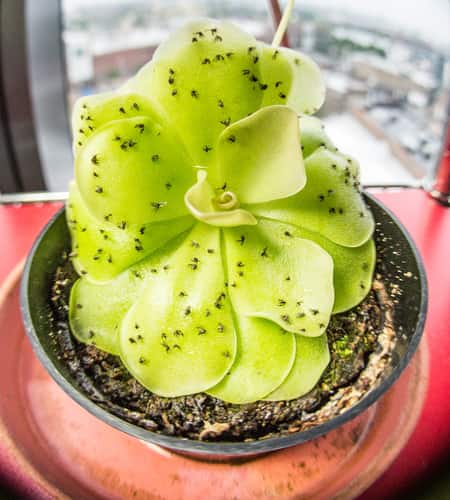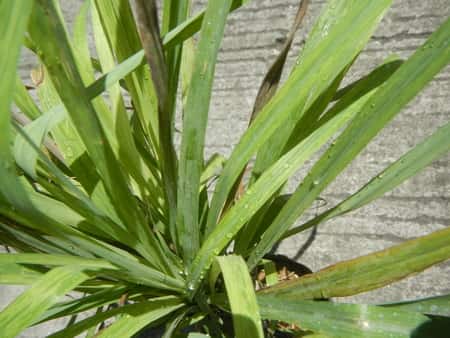Ants and orchids are never a good combination. One day you’re misting your orchids or watering them, and as soon as the water drenches the potting medium, here they come.
Ants: black, red, small, big, two, millions… No matter what kind of ants your orchid has, it’s not a good sign.

Orchids do not attract ants. They specialize in attracting specific species of bees, moths, butterflies, humming birds…but not ants.
What attracts the ants into your potting medium is that the other pests who produce a sugary sap have probably already infested the pot. The ants are attracted to your orchid to feed on the sap that aphids leave behind. Ants in themselves won’t harm your orchid, unless your orchid transpires (in excess) honeydew.
This isn’t as rare as you might think, and some genus produce more sap than others. Cymbidiums and Phalaenopsis can sometimes overproduce this liquid substance, and it will ooze out of the leaves, the flower spike, nodes, and even blossoms—more on that topic below.
Ants are fascinated, in the most, part to the sugar. To get to the sugar in your orchid, they’d have to eat the leaves, which they aren’t too fond of. What they’d prefer is to munch on the waste products that little critters like aphids that produce. In a sense, ants will take care of aphids, just to consume their excrements.
What also attracts ants is that the potting medium is a place that is perfect for building a home. It has air circulation, is well protected, and has light and darkness in a perfect proportion.
Once they settle in the potting medium, you have a problem.
Orchids That Thrive on Ants
Orchid do not attract ants, as I said before.
But I have to include one side note here: there are two orchid that do. As each orchid will produce pheromones (perfume) to attract a certain type of insect or pollinator, the Cham orchis alpine and the Frog Orchid specifically attract ants as their pollinators.
It’s highly doubtful that you will be cultivating these particular orchid genera, since the Cham Orchis Alpine grows in the subarctic plains of Russia, Scandinavia, and the Alps (unless you like your indoors near zero).
It’s amazing to me how well orchids have adapted to diversify into so many genera and species. Since life is extremely harsh in the subalpine parts of Europe, the Cham orchis had to attract what could live in those conditions, which happened to be ants and beetles.
The second orchid that attracts ants, Dactylorhiza viridis or the Frog Orchid, is more commonly found in the United States and Canada. It also has adapted to live from South Carolina all the way into Alaska, but didn’t confine itself to North America.
The Frog Orchid is a world traveler, found also in the colder parts of Europe and Asia. Its small green flowers are hardly noticeable among the abundant leaves. You can check out more information on this orchid from the North American Orchid Conservation.
Besides these two, not many other orchids attract ants. This means that if you have an ant infestation, then something else is attracting them. To properly rid your orchid of them, your need to find what’s alluring them into your potting medium.
Homemade Remedies or Pesticides to Control Ants?
You can buy an insecticide or pesticide, but don’t spray it directly on your orchid. This tutorial is not about the chemical products you can buy, since those are harmful for your orchid. (I did include one though, just in case your orchid-ant problem is very extreme. You might want to check out this company , which I thought was very good.)
, which I thought was very good.)

This is probably the most important part of this article: how to get rid of the ants.
Below are several suggestions on: 1)how to properly rid your orchid of ants and 2) how to prevent them from coming back again.
You’ll want to investigate more on what pest is attracting them to your potting medium, since you can treat the problem once, but if the underlying lure is still there, they’ll be back.
Ways to Eliminate Ants in Your Orchids
Baiting Lures Ants to Another Source
Baiting is a way to attract ants out of your pot and into other “traps” which kill them. There are ant traps which has sticky substances not letting the ant walk across, usually used for spiders. Also, on the market you can find tapes that lure flies into them. Place these on the floor around your orchid shelf.
If your ant problem is severe enough, you can use Diatomaceous Earth. This is a finely sliced rock cut so thin, that has micro-thin razor blades in it. The ants and other pests walk over it, and it pierces their exoskeleton. They dehydrate as the water leaves their bodies. Other pests will eat this, and literally lacerate from the inside in.
Always use gloves and a mask when using this material, since the same laceration will occur in your lungs. If you have small children and pets, this is not the ideal product.
Insecticidal Soap Physically and Chemically Removes Ants
In this method, you won’t be washing out the pot completely, but just washing your orchid with a mild soap. This is a good method if you don’t have many ants.
With a toothbrush, lightly and gently brush the stem and top side of the leaves with a soapy solution. Lightly and gently… Dilute the soap to a maximum, since this method is a bit harsh on your orchid. Lightly and gently… It works, no doubt, but it does make the orchid a tad bit uncomfortable.
Don’t use pure force or extreme pressure. If your orchid has aphids, then a light stroke is enough to get them off. The sap or honeydew they leave behind is the real problem. These will need to be scrubbed with a bit more force.
Never scrub the underside of leaves. This is where the majority of the orchids will “breathe”. You can rinse them off with a heavier jet of water, but don’t use the toothbrush here. Ironically, the underside of the leaf is where most pests and insects thrive, so don’t forget to rinse it down well.
Wash the Pot… Literally Scrub it Down
This is the most effective way of getting rid of ants. You don’t want to spray your potting medium with Raid of another kind of insecticide because this will definitely hurt your plant, but this method works just as if you sprayed.
Since ants burry themselves inside your potting medium, you’ll need to flush them out, and change the medium. Ants can lay eggs, and if you don’t kill the queen, even after flushing them out, they’ll still keep producing more ants.
Take your pot to the sink or wash bin and remove the pot. Outside is actually better, since ants can do wonders outside and actually help the environment. Inside, not as much.
Don’t repot your orchid in the same pot quite yet. You’ll need to wash out the pot, scrubbing thoroughly with soap and water, and preferably let the pot rinse with boiling water.
Eggs can attach to any little side, hole, niche, or cranny that the pot has. For now, I suggest using a different pot until you have some time to properly clean the old pot.
Under the water, rinse out the orchid removing all the potting medium possible. You’ll have to discard that potting medium since bark and charcoal are perfect for ant eggs. Rinse the bottom of the leaves carefully, since aphids prefer to live in the shade. Inspect the crown and stem of the orchid so you know for certain that no other living critters, pests, or insects are on your plant.
Repot the orchid once you’re certain that all the potting medium is removed from the orchid roots. You can apply hydrogen peroxide to the stem to be sure that you’ve killed all the bugs, but if you washed it well, this shouldn’t be necessary.
Carnivorous Plants will Eat Ants
This is my favorite way of getting rid of ants—carnivorous plants. I do confess that it isn’t the quickest or fastest, but it sure is the most satisfying. (That sounds cruel, but hey… don’t mess with my orchid.)
The most famous carnivorous plant is the Venus Fly Trap and is easily found in online store and at flower shops. There are others that are easily found, too, like the Butterwort and Pitcher Plants, like Cephalotus, Darlingtonia, Heliamphora, Nepenthes, and Sarracenia.

In both cases, they will produce the pheromones and the sap that attracts not only flies, but also ants and other pests into its “mouth”.
The butterwort, (as in the picture) has pretty petals and its flower looks like an orchid, too, so double-win on this one. Once the insect walks over its leaves, the leaves curl up and inward.
To rid of your ant infestation will takes months with this method. So, it’s definitely not the the quickest way to eliminate the invasion, but is great as a preventive measure in the future.
Ways to Keep the Eliminated Ants Gone for Good
Once you have eliminated the ant infestation, you now need to keep them from coming back. Below are several ideas, but you need to take into consideration your space, the conflicting smells of each methods, and the long term-results.
Citrus Rind
Another way to keep ants away in the future is to cut up citrus fruit rinds and place them around the orchid pots or even on the top of the potting medium. The rind (not the fruit) will repel insects.
Citronella Plant
The citronella plant has a strong smell of bathroom cleaning products or a dry sauna. If you can stand the smell inside your house (which I don’t suggest) then this plant is a good acquisition.
Citronella won’t kill the ants (or spiders for that matters) but the strong smell confuses their sense of direction. They’ll stay away from the plant, in order to keep a “peace of mind”.

This is the perfect plant to have outside around your house if you don’t want insects near your house.
Again, the smell is quite overwhelming and I personally couldn’t be around it more than a few minutes. They also grow quite huge if planted in the ground.
Humidity Tray and 2 Methods: Moat and Liquid Soap
Humidity trays should be something you’re familiar with if you’ve been growing orchids for some time. They’re great ways to raise humidity a few percentages on the relative humidity (rH) scale. Even though they don’t do wonders, like a humidifier will, they can be extremely beneficial for removing ants.
By the way, if you’re looking for good quality humidifier for a good price, then check out this article. I wrote this when I was searching for my humidifier and literally searched hundreds of humidifiers and read thousands of reviews, from ultrasonic, to wick, to cool-air… In this article I explain the difference between the kinds of humidifiers and how to choose one that suits what you want.
Back to the humidity tray… There are two ways to use humidity trays to fight off ants. The first one is to build a moat, raising the rock level higher in the middle. Pour water in the tray where there is no way for the ant to get across. You’ll have to use a larger humidity tray for this, but there are incredibly interesting ways to design this well.
The second way to use a humidity tray is to add soapy water to the pebbles. Even though the ants could walk across the surface of the pebbles, since your pot should not be sitting in water, the liquid soap will act as a repellent.
You can use baby shampoo, liquid detergent and other cleansing products. Just don’t get too carried away with the soap, since some more sensitive orchids will sense the soap as it evaporates and enters the leaf’s surface.
A little goes a long way.
Don’t Stop Learning!
If you want to be included in more information and get a 14-page fertilization guide, please sign up for my newsletter. I don’t spam, but send emails out bi-monthly with some curious topics of interest. If you want more information, click here to go to a specific page on this website where I explain it more in detail.

Also, if you are looking for an orchid journal to keep your notes specifically about orchid care, check out my 2 solutions for that on this page. If note-keeping isn’t your thing, then there is a free excel spreadsheet that you can download. Click here for more information on how to do that.
If you subscribe to my newsletter, I will send you a 14-page guide on the main tips of orchid fertilizer. It is downloadable and you can print it out on your computer. I designed the guide to double up as a coloring book, just to make it fun.
Spices; Cinnamon, Cloves, Chili powder, Coffee, or Dried Mint
Just like the citrus rind in the former paragraphs, ants aren’t too fond of spices. In Brazil, it wasn’t uncommon for restaurants to have a sliced lemon on the table with several cloves spike in the middle.
Not only does it make cute table decorations, it also is very functional.
You could also find cloves in the sugar pot, which would sit out on the tables and exposed to ants. But no ants got into the sugar because of the smell. The cloves didn’t change the sugar taste too much, so they are excellent to keep around.
Coffee grounds work too, but at a less extent. I like to use the various items and make an aromatic floral design that works well at table displays. Use cloves, chili, coffee, and mint leaves in small container and spread them across your orchid shelf. Shelving space for orchids is kind of a problem the longer you have orchids.
If you are having a problem with shelving and need some ideas to inspire more creative shelving, this article can give you some ideas of glass, metal, wood, and even upgraded grow-light shelves. If you’re not interested in buying something, but need ideas, take a look at our Pinterest Board for Indoor Grow Rooms , with lots of creative designs and methods for fitting more orchids into our lives. I hope you found some good methods to keep the ants away for good. If there is a method that you have tried and tested that isn’t mentioned above, give me shout out in the comments below. What has worked for you in the past?
, with lots of creative designs and methods for fitting more orchids into our lives. I hope you found some good methods to keep the ants away for good. If there is a method that you have tried and tested that isn’t mentioned above, give me shout out in the comments below. What has worked for you in the past?
Happy Cultivating!


There are MANY ant pollinated orchid species. Nearly the entire genus phragmipedium and paphiopedilum are thought to be pollinated by ants. Also, modern botany has barely touched on the subject of pollination, and we are still in our infancy. There is a good podcast about this subject on In Defense of Plants, that I am in no way associated with, just a fan.